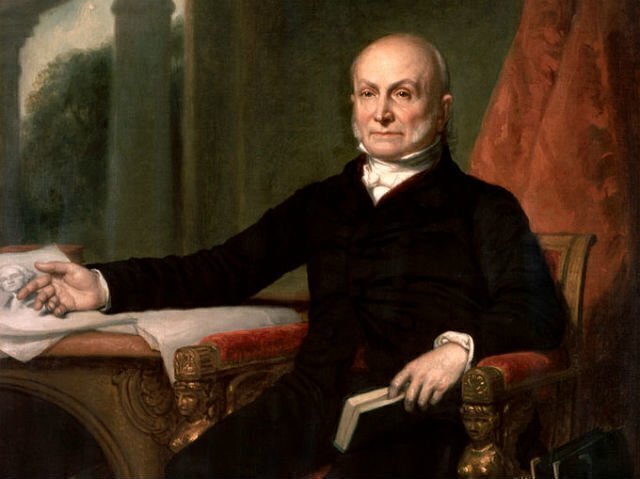 Today is the birthday of President John Quincy Adams. Though he served for only one term, the scion of John and Abigail Adams left an indelible mark on American history.
Today is the birthday of President John Quincy Adams. Though he served for only one term, the scion of John and Abigail Adams left an indelible mark on American history.
Our nation’s sixth President was born on July 11, 1767, in what is now Quincy, Massachusetts. He died on February 23, 1848, and is buried in Quincy at the First Unitarian Church. He is quoted as saying, “Always vote for principle, though you may vote alone, and you may cherish the sweetest reflection that your vote is never lost.”
1. Adams was very well educated. The young Adams studied in Paris, Amsterdam, Leyden, and the Hague, earning his bachelor’s degree from Harvard College in 1787. In fact, Adams House, one of the 12 undergraduate dormitories at Harvard, is named for Adams and his famous father, also a Harvard alumnus.
2. He became a lawyer without going to law school. Though he did earn a master’s degree from Harvard in 1790, Adams completed his legal education as an apprentice to the great Theophilus Parsons, who would eventually leave private practice in Boston to serve as Chief Justice of the Massachusetts Supreme Court. In this, he joins the pantheon of historical figures who were lawyers, including Alexander Hamilton and Abraham Lincoln, both of whom also never attended law school.
3. Adams was the driving force behind the Monroe Doctrine. In 1794, Adams began a career in international diplomacy, serving first as U.S. ambassador to the Netherlands. He went on to serve as ambassador to Prussia, Russia, and Great Britain before becoming the nation’s eighth Secretary of State under President James Monroe. In that posting, he shaped the Monroe Doctrine, which declared that any European attempt to colonize or interfere with the Americas would be viewed as a direct threat to the safety of the United States and worthy of intervention.
4. Double rainbow, meet double Senator! Shortly after concluding his service in Prussia, Adams was elected to the Massachusetts Senate in April 1802. He tried running for the U.S. House of Representatives in November that year but lost. Luckily for Adams, the Massachusetts legislature elected him to the U.S. Senate soon after, a post he held for five years before returning to diplomatic service.
5. Before Bush v. Gore, there was the election of 1824. In the eight years prior, the issues of slavery, states’ rights, regionalism, and the economy began to divide the dominant Democratic-Republicans, leading to a four-way presidential race in which no candidate obtained the necessary majority of electoral votes to win. As instructed by the 12th Amendment, the House held a runoff vote on December 1, 1824, in which Adams emerged victorious. Supporters of the war hero Andrew Jackson railed against a suspected “corrupt bargain” between Adams and Henry Clay, another opponent, the latter of whom interceded with Kentucky’s congressional delegation on Adams’ behalf.
6. The irrepressible John C. Calhoun served as Adams’ Vice President. Yes, that’s the John C. Calhoun who would go on to defend nullification as Vice President in explicit opposition to his boss, President Andrew Jackson. In 1824, however, Calhoun was above the fray, accepted by all presidential candidates as the obvious vice-presidential pick, no matter the victor. Disgusted by the “corrupt bargain,” Calhoun spent most of his term undermining Adams, filling key Senate posts with anti-Adams politicians and even casting a deciding vote against wool tariffs in 1827.
7. Adams lost a brutal reelection campaign to Andrew Jackson. The presidential election of 1828 featured one of the meanest, dirtiest campaigns in American history. Adams’ privileged background colored him an “elitist,” and Jackson supporters spread a rumor that, as ambassador, Adams offered an American girl to the Russian czar for sexual favors. On the other side, Henry Clay helped lead an attack on Jackson’s wife, Rachel; questions about her previous marriage led a Cincinnati newspaper to ask, “Ought a convicted adultress and her paramour husband be placed in the highest offices of this free and Christian land?” Adams was trounced.
8. Just a few years later, he became the only ex-President to serve in the U.S. House of Representatives. In 1830, Adams was elected to the House as part of the Massachusetts delegation; he would represent three districts over the course of his congressional career. Deeply interested in science, Adams ensured the founding of the Smithsonian Institution and became the father of space exploration in America, spurring construction of a network of astronomical observatories across the nation—so-called “lighthouses of the sky”—to study the heavens. He was also the first House member to champion abolition and emancipation.
9. Adams also argued a case before the Supreme Court—and won. On July 1, 1839, the illegally abducted slaves aboard The Amistad seized the ship, killing the captain and cook, and directing the surviving crew to return them to Africa. Instead, they sailed north, where the ship was seized by U.S. officials. Fights over property rights ensued, in which the slaves asserted their freedom. U.S. v. The Amistad was appealed all the way to the Supreme Court, where Adams argued on behalf of the slaves. The Court ruled in their favor, with Justice Joseph Story writing the opinion for a 7-1 majority. Adams is certainly not the only President to argue before the Court, though his case may be the most famous.
10. Sadly, he suffered a stroke on the House floor and died not long after. At age 78, Adams suffered a stroke while on the House floor. He mostly recovered—though he was left partially paralyzed—and returned to service within a few months. Two years after the stroke, on February 21, 1848, Adams collapsed during a debate about the Mexican-American War. He died two days later.
Nicandro Iannacci is a former web strategist and current consultant at the National Constitution Center.







